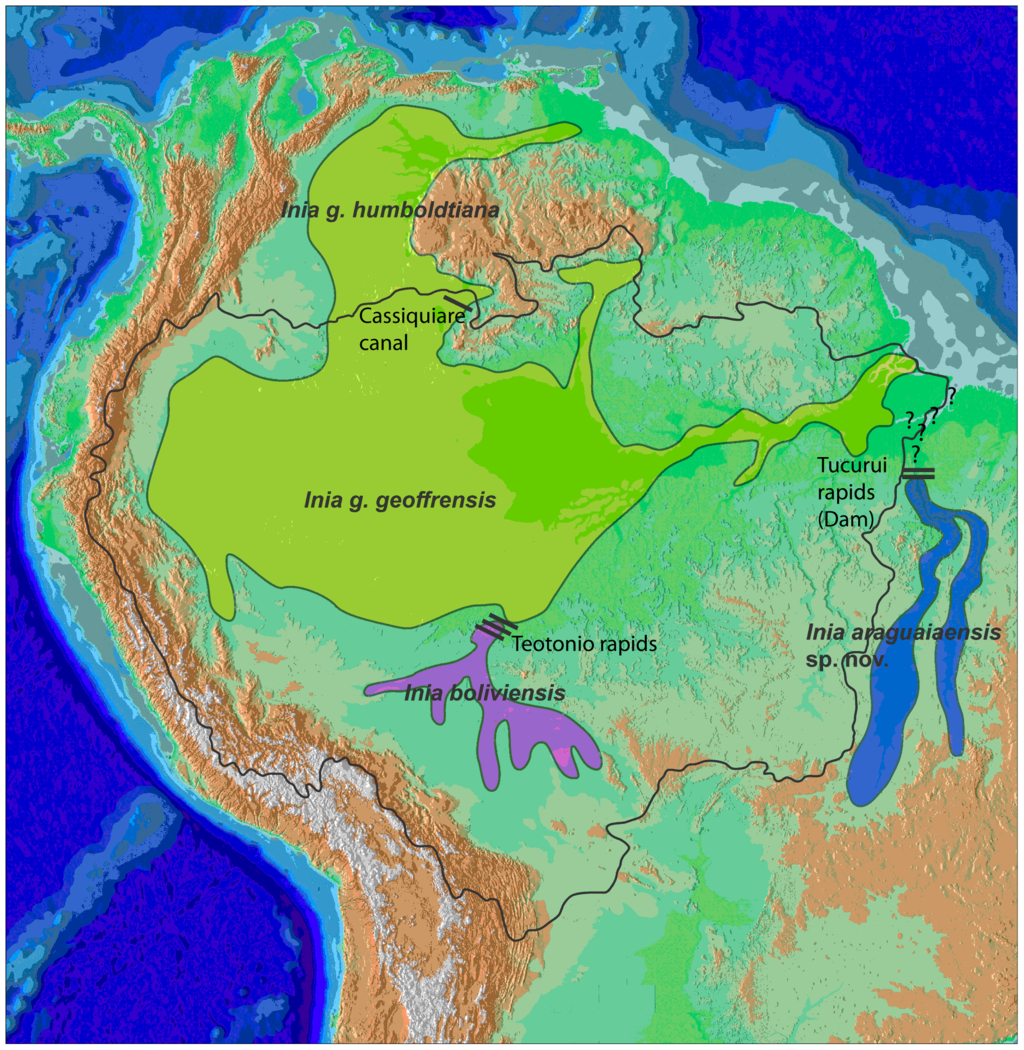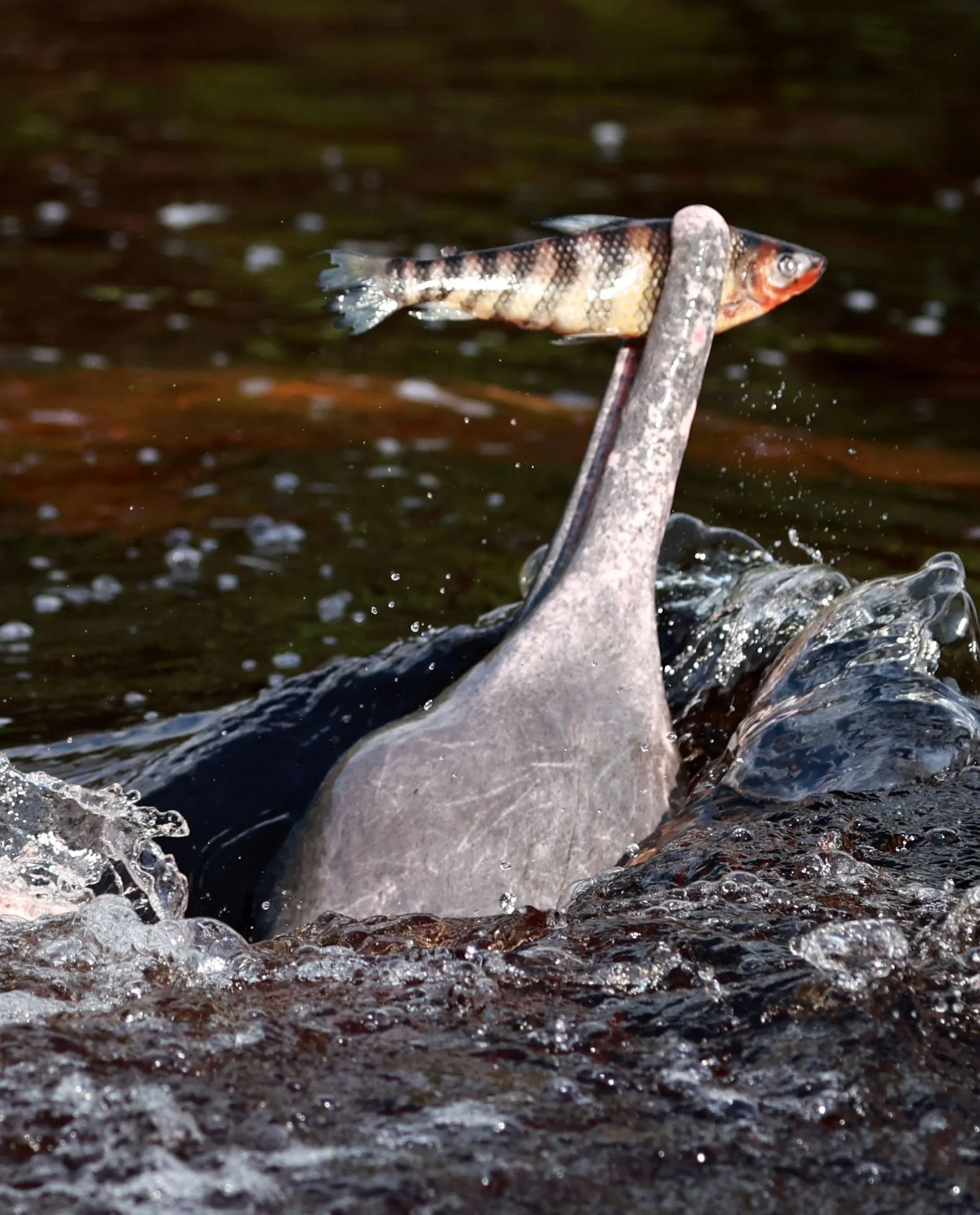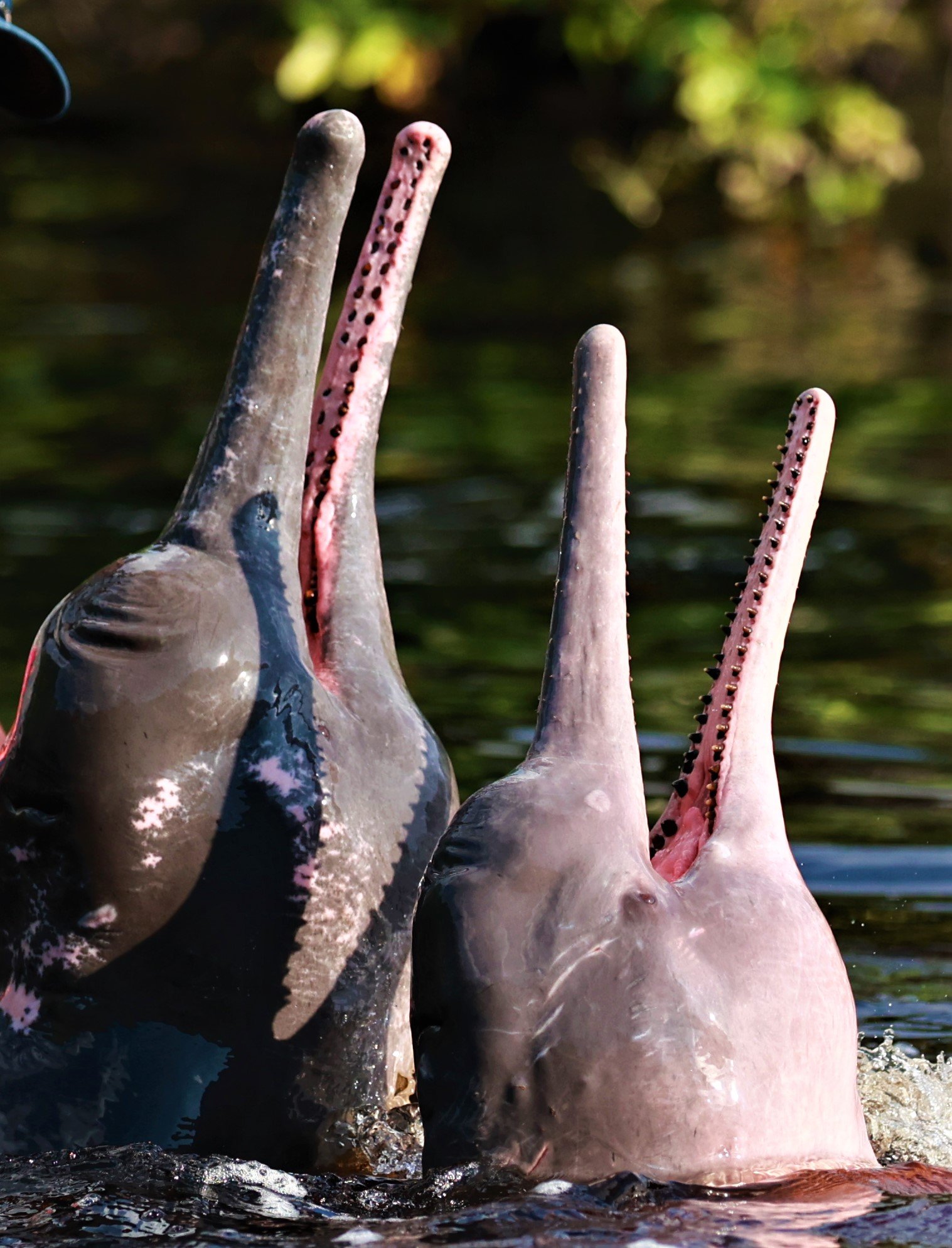
Amazon River Dolphin (Inia geoffrensis)
The Amazon River Dolphin (Inia geoffrensis), also known as the boto, bufeo or pink river dolphin, is a species of toothed whale which is native to and is exclusively of South America classified in the family Iniidae. Three subspecies are currently recognized: I. g. geoffrensis (Amazon river dolphin), I. g. boliviensis (Bolivian river dolphin) and I. g. humboldtiana (Orinoco river dolphin) while position of Araguaian river dolphin (I. araguaiaensis) within the clade is still unclear. The three subspecies are distributed in the Amazon basin, the upper Madeira River in Bolivia, and the Orinoco basin, respectively.
The Amazon river dolphin is the largest species of river dolphin, with adult males reaching 185 kilograms (408 lb) in weight, and 2.5 metres (8.2 ft) in length. Adults acquire a pink color, more prominent in males, giving it its nickname "pink river dolphin". Sexual dimorphism is very evident, with males measuring 16% longer and weighing 55% more than females. Like other toothed whales, they have a melon, an organ that is used for bio sonar. The dorsal fin, although short in height, is regarded as long, and the pectoral fins are also large. The fin size, unfused vertebrae, and its relative size allow for improved manoeuvrability when navigating flooded forests and capturing prey.
They have one of the widest ranging diets among toothed whales, and feed on up to 53 different species of fish, such as croakers, catfish, tetras and piranhas. They also consume other animals such as river turtles, aquatic frogs, and freshwater crabs.
In 2008, this species was ranked by the International Union for Conservation of Nature (IUCN) as being data deficient, due to the uncertainty regarding its population trends and the impact of threats. While hunting is a major threat, in recent decades greater impacts on population have been due to the loss of habitat and inadvertent entanglement in fishing lines.
The Amazon river dolphin are commonly seen singly or in twos, but may also occur in pods that rarely contain more than eight individuals. Pods as large as 37 individuals have been seen in the Amazon, but the average is three. In the Orinoco, the largest observed groups number 30, but the average is just above five. During prey time, as many as 35 pink dolphins work together to obtain their prey.Typically, social bonds occur between mother and child, but may also been seen in heterogeneous groups or bachelor groups. The largest congregations are seen in areas with abundant food, and at the mouths of rivers. There is significant segregation during the rainy season, with males occupying the river channels, while females and their offspring are located in flooded areas. However, in the dry season, there is no such separation. Due to the high level of prey fish, larger group-sizes are seen in large sections that are directly influenced by whitewater (such as main rivers and lakes, especially during low water season) than in smaller sections influenced by blackwater (such as channels and smaller tributaries). In their freshwater habitat they are apex predators and gatherings depend more on food sources and habitat availability than in oceanic dolphins where protection from larger predators is necessary.
Amazon River Dolphin feeding in the Ariau River, Brazil
Captive studies have shown that the Amazon river dolphin is less shy than the bottlenose dolphin, but also less sociable. It is very curious and has a remarkable lack of fear of foreign objects. However, dolphins in captivity may not show the same behavior that they do in their natural environment, where they have been reported to hold the oars of the fishermen, rub against the boat, pluck underwater plants, and play with sticks, logs, clay, turtles, snakes, and fish.
The diet of the Amazon river dolphin is the most diverse of the toothed whales. It consists of at least 53 different species of fish, grouped in 19 families. The prey size is between 5 and 80 centimetres (2.0 and 31.5 in), with an average of 20 centimetres (7.9 in). The most frequently consumed fish belong to the families Sciaenidae (croakers), Cichlidae (cichlids), Characidae (characins and tetras), and Serrasalmidae (pacus, piranhas and silver dollars). The dolphin's dentition allows it to access shells of river turtles (such as Podocnemis sextuberculata) and freshwater crabs (such as Poppiana argentiniana). The diet is more diverse during the wet season, when fish are spread in flooded areas outside riverbeds, thus becoming more difficult to catch. The diet becomes more selective during the dry season when prey density is greater.
Usually, these dolphins are active and feeding throughout the day and night. However, they are predominantly crepuscular. They consume about 5.5% of their body weight per day. They sometimes take advantage of the disturbances made by boats to catch disoriented prey. Sometimes, they associate with the distantly-related tucuxi (Sotalia fluviatilis), and giant otters (Pteronura brasiliensis) to hunt in a coordinated manner, by gathering and attacking fish stocks at the same time. Apparently, there is little competition for food between these species, as each prefers different prey. It has also been observed that captive dolphins share food.
Amazonian rivers are often very murky, and the Amazon river dolphin is therefore likely to depend much more on its sense of echolocation than vision when navigating and finding prey. However, echolocation in shallow waters and flooded forests may result in many echoes to keep track of. For each click produced a multitude of echoes are likely to return to the echolocating animal almost on top of each other which makes object discrimination difficult. This may be why the Amazon river dolphin produces less powerful clicks compared to other similar sized toothed whales. By sending out clicks of lower amplitude only nearby objects will cast back detectable echoes, and hence fewer echoes need to be sorted out, but the cost is a reduced biosonar range. Toothed whales generally do not produce a new echolocation click until all relevant echoes from the previous click have been received, so if detectable echoes are only reflected back from nearby objects, the echoes will quickly return, and the Amazon river dolphin is then able to click at a high rate. This in turn allow these animals to have a high acoustic update rate on their surroundings which may aid prey tracking when echolocating in shallow rivers and flooded forests with plenty of hiding places for the prey. While preying in murky water, they emit series of clicking noises, 30 to 80 per second, which they use by listening to the bouncing sonar which bounces off their prey.
Like other dolphins, river dolphins use whistling tones to communicate. The issuance of these sounds is related to the time they return to the surface before diving, suggesting a link to food. Acoustic analysis revealed that the vocalisations are different in structure from the typical whistles of other species of dolphins.
Amazon river dolphins are the most widespread river dolphins. They are present in six countries in South America: Bolivia, Brazil, Colombia, Ecuador, Peru, and Venezuela, in an area covering about 7,000,000 square kilometres (2,700,000 sq mi). The boundaries are set by waterfalls, such as the Xingu and Tapajós rivers in Brazil, as well as very shallow water. A series of rapids and waterfalls in the Madeira River have isolated one population, recognized as the subspecies I. g. boliviensis, in the southern part of the Amazon basin in Bolivia.
They are also distributed in the basin of the Orinoco River, except the Caroni River and the upper Caura River in Venezuela. The only connection between the Orinoco and the Amazon is through the Casiquiare canal. The distribution of dolphins in the rivers and surrounding areas depends on the time of year; in the dry season they are located in the river beds, but in the rainy season, when the rivers overflow, they disperse to the flooded areas, both the forests and the plains.
Studies to estimate the population are difficult to analyze due to the difference in the methodology used. In a study conducted in the stretch of the Amazon called Solimões River, with a length of 1,200 kilometres (750 mi) between the cities of Manaus and Tabatinga, a total of 332 individuals was sighted ± 55 per inspection. Density was estimated at 0.08–0.33 animals per square kilometer in the main channels, and 0.49 to 0.93 animals per square kilometer in the branches. In another study, on a stretch of 120 kilometres (75 mi) at the confluence of Colombia, Brazil and Peru, 345 individuals with a density of 4.8 per square km in the tributaries around the islands. 2.7 and 2.0 were observed along the banks. Additionally, another study was conducted in the Amazon at the height of the mouth of the Caqueta River for six days. As a result of the studies conducted, it was found that the density is higher in the riverbanks, 3.7 per km, decreasing towards the center of the river. In studies conducted during the rainy season, the density observed in the flood plain was 18 animals per square km, while on the banks of rivers and lakes ranged from 1.8 to 5.8 individuals per square km. These observations suggest that the Amazon river dolphin is found in higher density than any other cetacean.
The Amazon river dolphin is located in most of the area's aquatic habitats, including; river basins, major courses of rivers, canals, river tributaries, lakes, and at the ends of rapids and waterfalls. Cyclical changes in the water levels of rivers take place throughout the year. During the dry season, dolphins occupy the main river channels, and during the rainy season, they can move easily to smaller tributaries, to the forest, and to floodplains.
Males and females appear to have selective habitat preferences, with the males returning to the main river channels when water levels are still high, while the females and their offspring remain in the flooded areas as long as possible; probably because it decreases the risk of aggression by males toward the young and predation by other species.
The region of the Amazon in Brazil has an extension of 5,000,000 km2 (1,900,000 sq mi) containing diverse fundamental ecosystems. One of these ecosystems is a floodplain, or a várzea forest, and is home to a large number of fish species which are an essential resource for human consumption. The várzea is also a major source of income through excessive local commercialized fishing. Várzea consists of muddy river waters containing a vast number and diversity of nutrient rich species. The abundance of distinct fish species lures the Amazon River dolphin into the várzea areas of high water occurrences during the seasonal flooding.
In addition to attracting predators such as the Amazon river dolphin, these high-water occurrences are an ideal location to draw in the local fisheries. Human fishing activities directly compete with the dolphins for the same fish species, the tambaqui (Colossoma macropomum) and the pirapitinga (Piaractus brachypomus), resulting in deliberate or unintentional catches of the Amazon river dolphin. The local fishermen overfish and when the Amazon River dolphins remove the commercial catch from the nets and lines, it causes damages to the equipment and the capture, as well as generating ill will from the local fishermen. The negative reactions of the local fishermen are also attributed to the Brazilian Institute of Environment and Renewable Natural Resources prohibition on killing the Amazon river dolphin, yet not compensating the fishermen for the damage done to their equipment and catch.
Note the color and bulbous head of this Amazon River Dolphin near Manaus
During the process of catching the commercialized fish, the Amazon river dolphins get caught in the nets and exhaust themselves until they die, or the local fishermen deliberately kill the entangled dolphins. The carcasses are discarded, consumed, or used as bait to attract a scavenger catfish, the piracatinga (Calophysus macropterus). The use of the Amazon river dolphin carcass as bait for the piracatinga dates back to 2000. Increasing demand for the piracatinga has created a market for distribution of the Amazon river dolphin carcasses to be used as bait throughout these regions.
Of the 15 dolphin carcasses found in the Japurá River in 2010–2011 surveys, 73% of the dolphins were killed for bait, disposed of, or abandoned in entangled gillnets. The data do not fully represent the actual overall number of deaths of the Amazon river dolphins, whether accidental or intentional, because a variety of factors make it extremely complicated to record and medically examine all the carcasses. Scavenger species feed upon the carcasses, and the complexity of the river currents make it nearly impossible to locate all of the dead animals. More importantly, the local fishermen do not report these deaths out of fear that a legal course of action will be taken against them, as the Amazon river dolphin and other cetaceans are protected under a Brazilian federal law prohibiting any takes, harassments, and kills of the species.
The Amazon river is also threatened by the dumping of mercury into its waters from industrial mining, along with other harsh chemicals. Just like deforestation and burning, mercury in the water of the Amazon river is very dangerous for the fauna of the river. In 2019, F. Mosquera-Guerra at al, published a study that showed the presence of mercury in the Amazon river dolphins. They analyzed the dolphin's muscle tissue of different taxa of the Amazon basin and found high concentrations of mercury in the Tapajos River (Brazil) from an adult male of I. g. geoffrensis (pink dolphin).






























































































































